#catherine cobham
Explore tagged Tumblr posts
Text
Poetry as an act of resistance: A River Dies of Thirst by Mahmoud Darwish
A great poet is one who makes me small when I write, and great when I read. A River Dies of Thirst, the last volume of Mahmoud Darwish’s work to be released in Arabic, just eight months before his death in 2008, offers a precious opportunity to spend a little more time with a great poet as he casts a sorrowful eye at his beloved Palestine, and reflects on love, life, time, and memory. But more…

View On WordPress
#A River Dies of Thirst#Arabic#Archipelago Books#book review#books#Catherine Cobham#literature#Mahmoud Darwish#Palestine#Palestinian#poetry#translation
0 notes
Text
두려움의 법칙, 마흐무드 다르위시
The law of fear
- Mahmoud Darwish
- in A River Dies of Thirst: journals by Mahmoud Darwish, translated from Arabic to English by Catherine Cobham
The killer looks at the spectre of the dead man, not into his eyes, without regret. He says to those around him: ‘Don’t blame me. I’m afraid. I killed because I’m afraid, and I’ll kill again because I’m afraid.’ Some of those present, accustomed to favouring psychological analysis over the laws of justice, say: ‘He is defending himself.’ Others, admirers of the idea that progress is superior to morality, say: ‘Justice emanates from the generosity of power. The victim should apologise for the trauma he has caused the killer.’ Scholars of the distinction between life and reality say: ‘If this ordinary event had taken place anywhere but here, in this holy land, would we have even known the victim’s name? Let us then turn our attention to comforting the frightened man.’ When they went down the road of sympathising with the killer, some foreign tourists passing by asked them: ‘What has the child done wrong?’ They answered: ‘He will grow up and frighten the frightened man’s son.’ ‘What has the woman done wrong?’ They said: ‘She will give birth to a memory.’ ‘What has the tree done wrong?’ They said: ‘A green bird will appear from it.' And they shouted: ‘Fear, not justice, is the basis of power.’ The spectre of the dead man appeared to them from a cloudless sky and when they opened fire on him they did not see a single drop of blood, and they were afraid.
_
두려움의 법칙
- 마흐무드 다르위시
- 발췌: <강은 목이 말라 죽는다: 일���들> 마흐무드 다르위시, 캐서린 콥햄 아랍어에서 영어 옮김
살인자는 죽은 남자의 유령을 응시한다, 눈을 마주치지 않고, 후회 없이. 그는 주변 사람들에게 말한다: '내 탓을 하지 마십시오. 나는 두려웠습니다. 나는 두려웠기 때문에 죽였고, 두렵기 때문에 또 죽일 것입니다.' 그 자리에 있던, 정의의 법칙보다 심리 분석을 선호하는 것이 익숙한 이들은 말한다, '그는 자기를 방어한 것입니다.' 진보가 도덕보다 우월하다 생각하는 이들은 말한다: '정의는 권력의 너그러움에서 나오지요. 피해자는 살인자에게 트라우마를 야기한 것에 대해 사과해야 합니다.' 삶과 현실을 분간하는 학자들은 말한다: '이런 일상적인 사건이 이곳, 신성한 땅이 아닌 다른 어디에서든 일어났다면 우리가 피해자의 이름을 알기나 했겠습니까? 그렇다면 겁에 질린 남자를 위로하는 것에 관심을 돌립시다.’ 그들이 살인자에게 공감하자, 지나가던 외국인 관광객 몇이 그들에게 물었다: '아이가 무엇을 잘못했습니까?' 그들이 답했다: '자라면 겁에 질린 남자의 아들을 겁에 질리게 만들 것입니다.' '여자가 무엇을 잘못했습니까?' 그들은 말했다; '기억을 낳을 것입니다.' '나무가 무엇을 잘못했습니까?' 그들은 말했다: '거기서 초록새가 나올 것입니다.' 그리고 소리쳤다: '정의가 아닌 두려움, 그것이 권력의 근거다.' 구름 한 점 없는 하늘에서 죽은 남자의 유령이 그들 앞에 나타나자 그들은 죽은 남자의 유령을 총으로 쐈고, 피는 한 방울도 보지 못했으나 두려워했다.
_
1935년 11월 1일, 에드워드 사이드가 예루살렘, 팔레스타인에서 태어났다.
2023년 11월 1일, 이스라엘에 폭격을 당한지 하루도 지나지 않아 가자지구의 자발리아 난민촌이 두번째 폭격을 당했다. 수백명의 사람들이폭격으로 죽고, 가족을 잃고, 친구를 잃고, 폭격으로 무너진 건물의 돌무더기 아래 깔리고, 부상을 입었다. 가자지구에 투입된 이스라엘 지상군이 팔레스타인 사람들의 몸을 묶고, 그들의 눈을 가리고, 옷을 벗기고, 그들을 죽이고 짓밟는 영상이 공개됐다. 이것은 2023년에 처음 일어난 일이 아니다. 1948년 이래 꾸준히 75년간 수차례 일어난 일이다.
_
vimeo
위의 링크에서 11월 한 달 동안 팔레스타인 영화를 무료로 볼 수 있다.
_
팔레스타인 디아스포라 여성 Sofia Samarah 씨는 이렇게 말한다:
(IG: @sofiasamarah - 아래는 Sofia Samarah 씨의 인스타그램 게시물을 일부 번역한 내용이다. https://www.instagram.com/p/Cyv4rRJxzwa/?igshid=MzRlODBiNWFlZA==)
가자지구에서 일어나고 있지만 우리가 보지 못하는 것들:
먼지
폭탄이 떨어질 때마다 건물이 무너지고, 돌무더기가 섞이면서 더 많은 먼지가 생긴다. 모두가 먼지를 들이마시고 있다. 마스크는 없다. 산소호흡기도 없다. 물이 너무나 부족하기 때문에 사람들은 목과 눈과 코를 씻어내지 못한다.
소음
미사일, 폭발, 앰뷸런스, 도움을 요청하며 비명을 지르는 사람들, 사랑하는 사람들이 죽어 우는 사람들, 절망한 목소리들, 아이들의 울음소리. 집단학살이 일어나는 내�� 이 소리들이 들려온다.
부패
돌무더기 아래에, 닿지도 않는 곳에, 사람들의 몸들이 깔려있다. 현장에 있는 사람들은 적어도 1000명의 수습하지 못한 몸들이 있을거라 예상한다. 무너진 건물을 들어내기 위해서는 장비가 필요한데, 그것들을 들어낸 자리에는 죽임을 당한 몸들이 있을 것이다. 무너진 건물을 들어내는 것은 어떤 몸들이 죽임을 당한 지 몇 주가 지난 후에야 가능할지도 모른다. 죽은 살 냄새가 가자지구의 공기를 채운다.
배설물
물이 끊긴 상태에서 화장실 물을 내리는 것 또한 불가능하다. 가자지구 대부분의 화장실이 작동하지 않는다. 몇 시간씩 줄을 서서 화장실에 가거나, 볼 일을 볼 수 있는 곳에서 일을 해결해야 한다. 휴지와 여성 위생용품을 구하는 것이 어렵다. 사람들은 볼 일을 보는 것을 최대한 참아야 한다. 물이 없어 수분섭취 또한 부족하고 불가능한 중에, 화장실을 제대로 이용할 수 없는 것이 다시 염증과 질병을 유발할 것이다.
쓰레기
쓰레기, 피에 흠뻑 젖은 옷, 음식물 쓰레기 등이 수거되지 못하고 쌓이고 있다.
파리
죽임을 당한 몸의 부패로 인해 엄청난 수의 파리가 꼬인다. 파리가 죽임을 당한 사람도, 살아남은 사람도 물고, 쓰레기와 얼마 남지 않은 물과 식량 위에 앉는다.
불면
가자지구의 사람들은 길어야 하루 3-4시간의 수면을 취한다고 한다. 계속 되는 소음과 두려움, 절망과 트라우마로 그들은 불면에 시달리고, 탈진하게 된다. 불면으로 반응 속도가 느려지고, 면역력이 떨어진다.
굶주림
점점 식량 부족의 문제가 심각해지고 있다. 부모들은 아이들에게 음식을 양보하고 굶기도 한다. 하루치 음식을 받기 위해 사람들은 몇 시간 동안 줄을 서야 한다. 사람들은 파괴된 주택에 남은 오염된 음식이라도 모으고 있다.
무력감
가자지구에 있는 그 누구도 자신이 안전하다 느끼지 않으며, 그 누구도 자신이 무사할거라 믿지 않는다. 다음은 자기 차례일 거라 생각하며 기다린다. 들은 죽임을 당했을 시의 신원확인을 대비해 팔에 이름을 쓴다. 실제로, 어떤 아이들의 몸들은, 아이들이 살아있을 때 팔에 이름을 써두지 않았더라면 신원확인을 하는 것이 불가능했을 것이다.
_
*번역 중에 '시체', '사체', '시신'과 같은 단어들의 의미와, 그러한 단어를 사용하는 것의 의미에 대해 생각해보게 되었다. 이 단어들은 죽음을 어떻게 그려내는 단어들일까. 충분히 찾아보고 고민하지 못했지만, 팔레스타인 사람들이 전 세계가 지켜보는 가운데 매일 매일 죽임을 당하고 있는 상황에서, '시신'��나 '시체'와 '사체'가 죽임을 당한 사람의 몸을 하나의 숫자로 만들어버리고, 죽임을 당하기 이전의 삶을 지우거나 보이지 않게 만드는 것은 아닐까, 생각이 들어 dead body를 '죽임을 당한 몸'이라 번역했다.
#free palestine#from the river to the sea palestine will be free#stop genocide#ceasefire now#mahmoud darwish#catherine cobham
1 note
·
View note
Text
I've been thinking about how Katherine J. Lewis made this remark about Catherine de Valois and Isabeau of Bavaria
It is often claimed, without supporting evidence, that Isabeau was notoriously promiscuous, sometimes in discussions of Katherine. Strickland strongly implies this, calling Isabeau a “wicked woman” and a “degraded woman.” None of the scholarship on Katherine has explicitly drawn comparisons with her mother. Yet the two have received parallel treatment because the claim that Katherine was governed by her fleshly passions is taken at face value, without acknowledgement of the ideological implications of such obviously gendered criticism. (x)
Because while scholarship doesn't make this comparison*, there's Denise Giardina's Good King Harry and Brenda Honeyman's Good Duke Humphrey, where Catherine is presented as the young and beautiful version of her mother - conniving, evil, promiscuous. Since Giardina describes Isabeau in quite grotesque terms, there's also the implication that Catherine will one day become as monstrous in appearance as her mother, her exterior finally matching her interior.
However, the vast majority of novels about Catherine are sympathetic and view her 'notorious promiscuity' as an unfair and untrue slander that denies Catherine's status as a romantic heroine. These novels are frequently positioned as interventions, reclaiming Catherine's story as a tale of true love.
All the while, however, these novels stick to the traditional view of Isabeau of Bavaria. She is still "conniving, evil, promiscuous", fat and thus grotesque, and an abusive mother (this characterisation also pops up in novels about Isabelle de Valois too, though Isabelle's reputation is for tragedy, not romance or promiscuity). Typically, Isabeau terrorises Catherine as a child, coldly pimps her out once she's of an age to be married, and always derides her. Isabeau, often depicted as physically repulsive because of her obese, aged body, is also frequently jealous of Catherine for her youth and beauty. Giardina presents Isabeau on the other hand as being absolutely deluded about her appearance, imagining herself to be as beautiful and as sexually desirable as Catherine to the point where she offers herself sexually to her son-in-law upon hearing Henry V has quarrelled with her daughter. The scene makes clear her delusion by focusing on Henry's revulsion of her physical body which she has exposed to him a grotesque attempt at seduction.
While the purpose Isabeau serves in these narratives is both a matter of perceived "historical accuracy" (though some of these books were published after the historical reassessments of Isabeau by the likes of Tracy Adams and Rachel Gibbons) and to render Catherine as sympathetic as possible (setting the scene for her "rescue", usually by either Henry V or Owen Tudor, both serving as her romantic hero), it also feels like Isabeau is being used as to refute Catherine's reputation for "notorious promiscuity", presenting Isabeau as the most monstrous iteration of that so that the behaviour that earns Catherine that reputation is always considered a far lesser, if not wholly unproblematic, infraction.
In other words, Isabeau is the dark mirror of Catherine. Isabeau's sexual desires are about the physical, not the personal. She is insatiable and undiscerning, concerned only with her own gratification. She's at the mercies of her uncontrollable lust, bestial, and ultimately shallow. But Catherine? Catherine is driven by only pure emotions. She's in love, she's a romantic. Catherine doesn't fuck, she makes love. Catherine is the furtherest thing from a slut - a woman searching for true love. If you want to see a real slut, look at Isabeau. Not Catherine, a martyr to true love.
(Or Eleanor Cobham, who often serves as an antagonist to Catherine after Catherine is widowed - though, unlike Isabeau, Eleanor's scandalous sexuality is often suppressed. She coldly uses her sexuality to advance, unlike Isabeau, who is overcome by lust, or Catherine, who is in love. Eleanor, it could be argued, serves a dark mirror of Owen Tudor - the lover of lesser status who advances through the sexual conquest of a high status individual.)
None of these women's reputation for promiscuity is particularly warranted by modern standards. Isabeau's alleged adulteries come from Burgundian propaganda that aimed to undermine her and Louis, Duke of Orleans, or else developed in the years after the Treaty of Troyes to discredit Charles VII's claim to the throne. There is no evidence that this was anything more than slander. Catherine's reputation was borne from the fact she secretly remarried after Henry V's death to a man of lower status in defiance of the minority council. Eleanor's one known sexual relationship was with a man she later married and who probably should be considered estranged from his wife at the time. Eleanor could be considered as a homewrecker (though I would argue such a label ignores the political circumstances in which Humphrey, Duke of Gloucester's first marriage fell apart) but not necessarily promiscuous. But even if they were promiscuous, isn't time we moved on from demonising women for their sexuality?
* Well, John Ashdown-Hill calls Isabeau of Bavaria "something of an nymphomaniac" and says it's "possible that Catherine inherited her mother's strong sexuality", but I hardly count him as a scholar and you can't inherit sexuality, wtf.
8 notes
·
View notes
Note
I saw a post going around about Henry V's looks, so I wonder if you happen to know the hair colour of his siblings? I know the hair colours of some Plantaganets, but frankly I've never looked for those of Henry's siblings before.
Hello! So, there's really only information about what colour hair three of Henry V's five siblings had and only one case where I feel we can be 99.9% certain of the hair colouring.
I'll go into a lot more detail (with photos! and my trademark rambling!) below the cut but basically:
Thomas, Duke of Clarence: unknown
John, Duke of Bedford: dark brown
Humphrey, Duke of Gloucester: probably dark brown
Blanche of England: possibly blonde or red
Philippa of England: unknown
John, Duke of Bedford's hair is depicted as brown in two extant manuscripts that belonged to him. Depictions in manuscripts are problematic as far as "true likenesses" go. The artist might not know what their subject look like so they cannot make a true-to-life likeness even if they wanted to. Or they might be making an idealised or generic portrait where what's important is more what the figure represents (i.e. status as king, queen, duke etc.) rather than what the figure really looked like.
But these two manuscripts depict John in what appears to be an effort to depict a reasonable likeness of him (you can tell by the nose). The Bedford Hours has the most detailed and fine portrait, where he has dark brown hair, an aquiline nose and it seems grey eyes (the weird five o'clock shadow around the side of his face and under his jaw is probably the result of pigment wearing off, though).
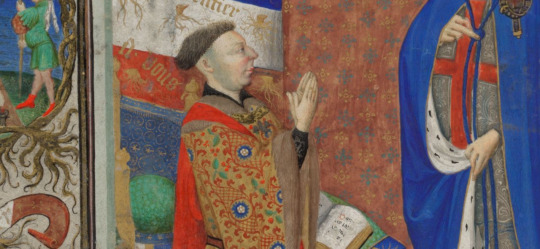
The portraits in the Salisbury Breviary are overall less detailed but are still personalised enough (see: the nose) that we can say that they were probably made to resemble him:


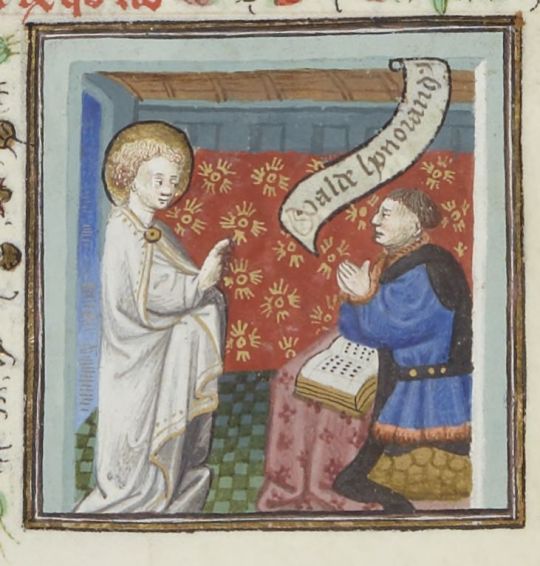
And if that's not enough, his remains were discovered in 1860 and his hair colour was noted as "dark" or "black". The remains themselves were noted as being blackened so I'd guess the processes of embalming/decay probably darkened his dark brown hair to black.
The flip side of the manuscript problem is Humphrey, Duke of Gloucester, where we have four different depictions from four different contemporary/near-contemporary manuscripts, where his hair ranges from light brown (or dark blond, if you'd rather) to dark brown to black, including one where he looks bald but if you zoom in close enough, he has a very short crop of dark hair underneath his crown.
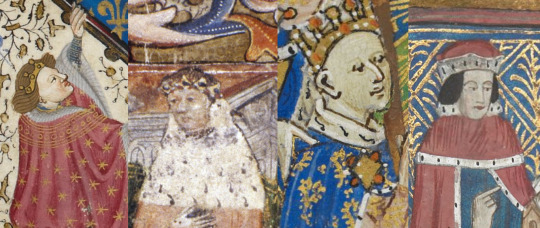
The first is from the Talbot-Shrewsbury Book (made in Rouen, 1444/5), the second from the presentation copy of John Capgrave's Commentary on Exodus (made in England, c. 1440); the third from the Psalter of Humfrey of Gloucester (made in England in the second quarter of the 15th century, before 1447) and the fourth from the St. Albans Benefactor Book (made in St Albans monastery, begun 1380 and finished c. 1540). All of these can be connected with people who knew Humphrey and thus knew what he looked like (though it's not clear when the fourth was made, it may have been long after his lifetime), though as with all manuscripts, he may have been represented as a generic royal duke/patron/donor instead of an attempt being made at a reasonable likeness.
What is striking about them is how different they are not only from the uniform likenesses of John but from each other. If second and third have the same type of hair colour, the faces are noticeably different. None of them resemble the copy of Humphrey's portrait that closely either (though, of course, a portrait has a lot more room for detail and personalisation).
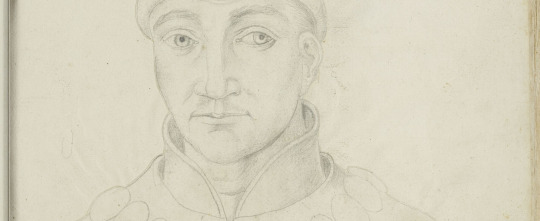
However, the second and third are the most interesting in terms of hair colour because they both depict Humphrey with dark brown hair and were both made in Humphrey's lifetime by English illuminators - the third was almost certainly commissioned by Humphrey himself - so they have the best chance of being reasonably true to how he looked.
But in case that sounds too easy an answer, Humphrey's corpse was also rediscovered in the 1700s and his hair is said to have been yellow. Elizabeth, countess of Moira and a "proto-archaelogist", took some of the hair, noted the colour and that it was strong enough to be woven "Bath rings". She also suggested that the colour of the hair was not as it had been in life but it was "the nature of hair to gain that yellowish hue in the grave" - in other words, Humphrey may have been grey- or white-haired at death and the materials used in embalming bleached or discoloured his hair.
Although being the most obscure sibling, Blanche of England is the perhaps the only other sibling where there's any information about her hair colour. We have this image which I believe is a copy of a near-contemporary image of her (in the centre):

I can't remember or find where I got the information about it being a copy of a near-contemporary original, though, so I might be wrong. As we can see, she appears to have hair that is somewhere on the blond to red spectrum (I read it as ginger but though this is the highest resolution I can find, it's clearly poor quality (cf. the lines on the faces) so the colours might be distorted). The painting might represent Blanche as an idealised queenly figure rather than an attempt to represent her truthfully - though the fact it depicts her with a crown similar to the Palatine Crown she brought as her dowry is suggestive that they were trying to depict her in a way that made her easily identifiable.
Her name, "Blanche", might also be suggestive, as she was named after her grandmother, Blanche of Lancaster, Duchess of Lancaster (daughter of Henry of Grosmont, the first wife of John of Gaunt) whose hair was described by Chaucer as golden:
For every heer upon hir hede, Soth to seyn, hit was not rede, Ne nouther yelow, ne broun hit nas; Me thoghte, most lyk gold hit was. (The Book of the Duchess, ll. 855-858)
Of course, it's possible that Blanche was merely named in honour for her grandmother and there was no resemblance. But given Blanche means "white", it's possible that she was named in honour of her grandmother and because her hair was a similar colour.
I'm not aware of any contemporary surviving contemporary images of Philippa of England, though we have an image from 1590 that shows her with blonde (reddish-blonde?) hair and an stained glass window from the 19th century that shows her with dark hair:

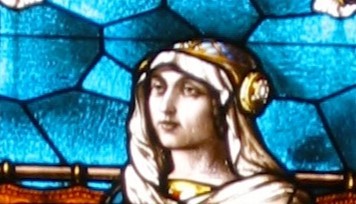
We do have a near-contemporary image of Thomas, Duke of Clarence but... it's his alabaster tomb effigy and he's shown wearing a helm and is without moustache and beard so we have no idea of the colour of his hair.
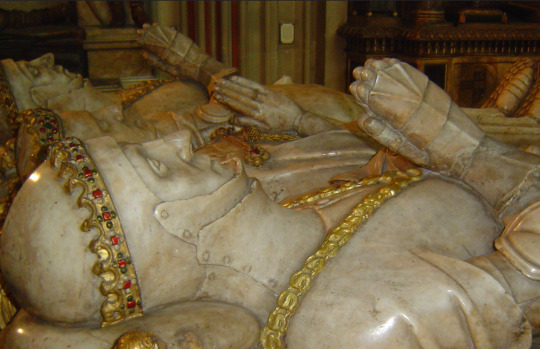
But the Lancaster siblings probably every hair colour in their gene pool. Henry IV was said to have had "russet" hair when his tomb was opened (though we can't dismiss the possibility that his hair only appeared russet due to the way that red pigment can decay slower than others). Mary de Bohun is depicted as blonde in donor portraits in her psalter and Book of Hours (though it might be an idealised portrait than realistic). Their paternal grandmother, Blanche of Lancaster, was blond, their great-grandparents Philippa of Hainault and Edward III appear to have been black-haired and blonde respectively and red-hair is strongly associated with the Plantagenet line. So while Henry V, John and Humphrey all seeming to have dark brown hair is perhaps indicative of a family trait, I don't think that means Thomas, Blanche and Philippa must have had it too - and Blanche may well have been blonde or ginger.
#thomas duke of clarence#john duke of bedford#humphrey duke of gloucester#blanche of england#philippa of england#text posts#yoghurtbattle#asks#(as for the spouses margaret holland has blond hair in some manuscripts#catherine de valois's effigy had strands of brown hair#and there's a lock of blond hair said to be taken from jacqueline of hainault's tomb though they also said they couldn't find her tomb)#(no information about eleanor cobham or anne of burgundy or jacquetta of luxembourg i believe)#lancasterlings
11 notes
·
View notes
Text


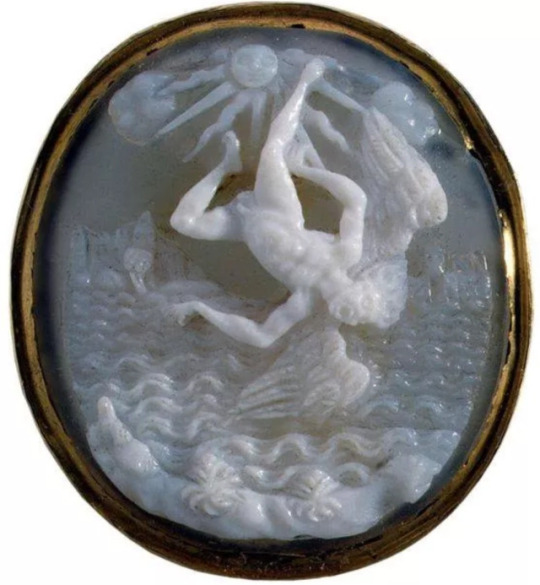






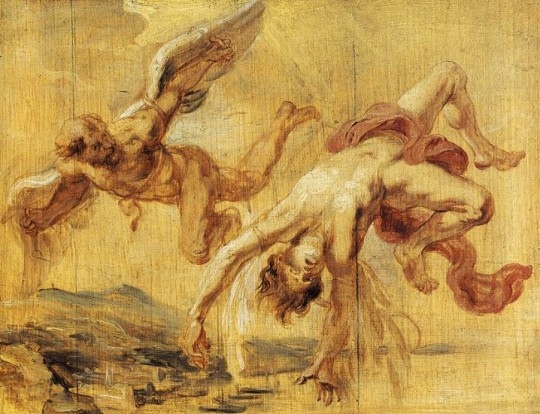


though i am heavy, there is flight around me
wendell berry, the fall of icarus, f. scott fitzgerald, christophe vacher, hozier, galileo chini, mahmoud darwish (tr. catherine cobham), rubens, akwaeke emezi, alfred schwarzschild
#web weavings#quotes#literature#poetry#classic literature#icarus#heaviness#what do i do with this unbearable heaviness?#art#poems#paintings#parallels#art parallels#hozier#unreal unearth#wendell berry#f scott fitzgerald#translated literature#mahmoud darwish#rubens
4K notes
·
View notes
Text
Massacre is a dead metaphor that is eating my friends, eating them without salt. They were poets and have become Reporters With Borders; they were already tired and now they're even more tired. 'They cross the bridge at daybreak fleet of foot' and die with no phone coverage. I see them through night vision goggles and follow the heat of their bodies in the darkness; there they are, fleeing from it even as they run towards it, surrendering to this huge massage. Massacre is their true mother, while genocide is no more than a classical poem written by intellectual pensioned-off generals. Genocide isn't appropriate for my friends, as it's an organised collective action and organised collective actions remind them of the Left that let them down.
Massacre wakes up early, bathes my friends in cold water and blood, washes their underclothes and makes them bread and tea, then teaches them a little about the hunt. Massacre is more compassionate to my friends than the Universal Declaration of Human Rights. Massacre opened the door to them when other doors were closed, and called them by their names when news reports were looking for numbers. Massacre is the only one to grant them asylum regardless of their backgrounds; their economic circumstances don't bother Massacre, nor does Massacre care whether they are intellectuals or poets, Massacre looks at things from a neutral angle; Massacre has the same dead features as them, the same names as their widowed wives, passes like them through the countryside and the suburbs and appears suddenly like them in breaking news. Massacre resembles my friends, but always arrives before them in faraway villages and children's schools.
Massacre is a dead metaphor that comes out of the television and eats my friends without a single pinch of salt.
Ghayath Almadhoun, "Massacre", Adrenalin, trans. Catherine Cobham
784 notes
·
View notes
Text
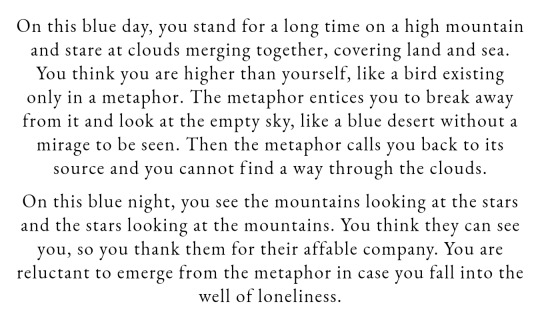
Mahmoud Darwish, from "A Metaphor", A River Dies of Thirst: Journals (tr. by Catherine Cobham)
#mahmoud darwish#a river dies of thirst: journals#lit#literature#poetry#palestinian literature#palestinian poetry#*
319 notes
·
View notes
Quote
I walk lightly so as not to crush my cheerfulness. I walk heavily so as not to fly.
Mahmoud Darwish, from “From now on you are you,” A River Dies of Thirst (trans. Catherine Cobham)
#q#lit#quotes#poetry#mahmoud darwish#a river dies of thirst#from now on you are you#palestinian lit#fragments of selfhood#reading#m#x
971 notes
·
View notes
Text

Mahmoud Darwish, trans. Catherine Cobham, from A River Dies of Thirst
368 notes
·
View notes
Note
Now that the Histories Ficathon is over I'm making good on my threat/promise... please assign the Lancasterlings (and their spouses, if you want) a prehistoric creature to go alongside Thomasaurus Rex.
yes...haha yes! 😈
this got long so under the cut:
Henry V:
Okay hear me out- we keep keep the swan theme and connection to Mary and her family as strong, tight throughline also I love the idea of Hal beating up people aggressive-swan-style. But- hear me out- bigger. So I'm thinking the giant Pleistocene swan Cygnus falconeri. It's a beautiful morning in France, and you are a horrible swan.
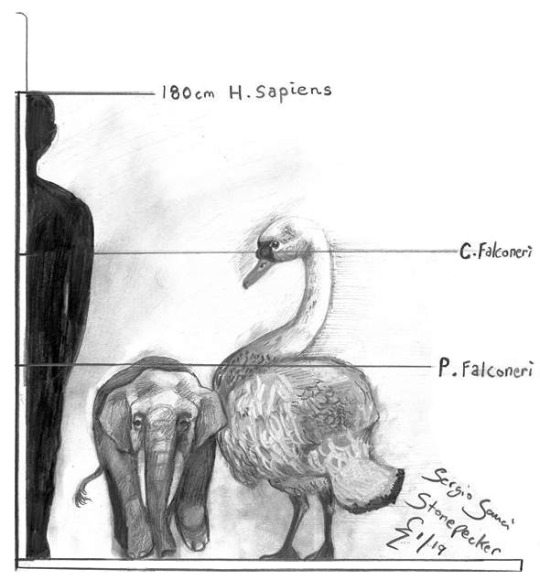
Artist: Sergio Gauci
Given Henry VI may have gotten his panther badge from his mom, may I also propose for Catherine de Valois the Eurasian extinct giant cheetah species Acinonyx pardinensis?

Artist: Velizar Simeonovski
Thomas, Duke of Clarence:
Obviously a T. rex, but I'm gonna stick this bit in from Brusatte's The Rise and Fall of the Dinosaurs to show how perfect that choice is 🤌✨

I admittedly know very little about Margaret Holland, but I was kind of compelled by how her children from her first marriage were kept in her and Thomas' household...that and Margaret wanting her book of hours to prepare her to "always be redy to dye," reminds me of the oviraptorid fossil that died and was preserved in position of protecting its eggs. Something about that as a parallel to her being buried alongside both her husbands too....

Artist: Zhao Chuang
John, Duke of Bedford:
Maybe it's because he himself seemed constantly stressed and running around doing some sort of assignment, and in the plays it's sometimes played as if he dies from sheer exhaustion, but I kind of like the idea of a beardog like Ischyrocyon or Amphicyon. The beardogs were famously generalists in hunting and in both of the above genera, it's hypothesized they may have been persistence hunters.
youtube
Also voting for Anne of Burgundy as an alvarezsauroid like Mononykus or Shuvuuia, which have been compared to nocturnal avian hunters like owls 🤎🤍

Humphrey, Duke of Gloucester:
So a guy having a pretty productive relationship to his family (not perfect, but pretty good compared to others I could name...) trying his best to be an actual protector of his relative's kid, having a lot of relationship drama, and also getting into spats with people reads as very ceratopsian to me lmao. To de-fang him a just a little, I'm going with Kosmoceratops. Those folded horns on the top edge of the frill and side-facing brow horns probably aren't going to help you that much at Agincourt, but I'm sure that pretty lady from Cobham thinks they're fire 👍

Artist: Lukas Panzarin
Speaking of: I like the idea of Eleanor of Cobham maybe being assigned with some sort of plesiosaur? Sort of bridging the siren to mermaid to modern creature of our mythical imagination Nessie pipeline :)

Artist: James Kuether
For Jacoba, Smilodon. They're smart and fierce so fitting. Also what she deserves ❤️🔥

Artist: Mehdi Nikbakhsh
Blanche:
Unfortunately I couldn't find a whole lot on her, but that sort of elusive energy kind of reminds me of Coelurus fragilis, a possible Jurassic relative of the tyrannosaurs, but not much is known about their evolution or ecology. That and it being a more gracile and swift-footed creature kind of has Blanche vibes to me 🤍

Artist: Nobu Tamura
Ludwig deserves nothing and gets nothing bye
Philippa, Queen of Denmark, Sweden, and Norway:
I know in the fic poor Philippa seems pretty freaked out by Thomasaurus' size, but I'm partial to her being a big death lizard too– maybe like those coming-of-age mermaid stories but she's...bigger and teeth-ier 😅. For a similar reason to seeing what Thomas would do at Baugé, I'd like to see Philippa defend Copenhagen as a Mosasaurus hoffmannii. Let's see the Hanseatic League try to get past THIS 🫡 min dronning 🫡

I like the idea of Erik also being associated with something aquatic though maybe not as intimidating as Philippa...maybe an early whale relative like Dorudon?

Artist: David Arruda Mourao
7 notes
·
View notes
Text

I have grown tired of long dreams that take me back to the point where they begin and I end, without us ever meeting in the morning.
•Mahmoud Darwish•
#MahmoudDarwish, from “I did not dream’' in: “A River Dies of Thirst. Journals” by Mahmoud Darwish, translated from the Arabic by Catherine Cobham #photo Philomena Famulok
20 notes
·
View notes
Text
It was the most beautiful war I’ve been in in my life, full of metaphors and poetic images, I remember how I used to sweat adrenalin and piss black smoke, how I used to eat my flesh and drink screams, death with his scrawny body leaned on the destruction committed by his poem, and wiped his knife clean of my salt, and the city rubbed my shoes with her evening and the street smiled and the city counted the fingers of my sorrow and dropped them on the road leading to her, death weeps and the city remembers the features of her killer and sends me a stabbing by post, threatening me with happiness, and hangs my heart out on her washing line strung between two memories, and oblivion pulls me towards myself, deeply towards myself, deeply, so my language falls on morning, and balconies fall on songs, headscarves on kisses, back streets on women’s bodies, the details of alleyways on history, the city falls on the cemeteries, dreams fall on the prisons, the poor on joy, and I fall on memory.
Ghayath Almadhoun, from Details (trans. Catherine Cobham)
42 notes
·
View notes
Text
숲, 마흐무드 다르위시
The Forest
- Mahmoud Darwish
- in A River Dies of Thirst: journals by Mahmoud Darwish, translated from Arabic to English by Catherine Cobham
I couldn’t hear my voice in the forest, even if
the forest were free of the beast’s hunger
and the army defeated or victorious – there’s no difference –
had returned
over the severed limbs of the unknown dead to the barracks
or
the throne
And I couldn’t hear my voice in the forest, even if
the wind carried it to me, and said to me:
‘This is your voice,’ I couldn’t hear it
I couldn’t hear my voice in the forest, even if
the wolf stood on his hind legs and applauded me:
‘I can hear your voice, so give me your orders!’
And I said: ‘The forest is not in the forest
Father wolf, my son!’
I couldn’t hear my voice unless
the forest were free of me, and I were free of
the silence of the forest.
_
숲
- 마흐무드 다르위시
- 발췌: <강은 목이 말라 죽는다: 일기들> 마흐무드 다르위시, 캐서린 콥햄 아랍어에서 영어로 옮김
숲속에서 나의 목소리를 들을 수 없었다, 숲은
짐승의 굶주림으로부터 자유로움에도
패전하거나 승리한 - 차이는 없다 - 군대는
돌아왔다
누군지 모를 고인의 잘려나간 팔다리를 밟고, 막사로 혹은
왕좌로
그리고 숲속에서 나의 목소리를 들을 수 없었다, 바람이
나의 목소리를 내게 가져다주었음에도, 내게 말했음에도:
‘이것이 너의 목소리다,’ 나는 들을 수 없었다
숲 속에서 나의 목소리를 들을 수 없었다, 늑대가
뒷발로 서서 내게 박수를 보냈음에도:
‘너의 목소리를 들을 수 있으니, 나에게 명령을 내려줘!’
그리고 나는 말했다: ‘숲은 숲속에 없어
나의 아들, 아빠 늑대야!’
나의 목소리를 들을 수 없었다, 숲이
나에게서 자유롭지 않은 한, 내가 자유롭지 않은 한
숲의 침묵으로부터.
마흐무드 다르위시 인터뷰
#ceasefire now#stop genocide#free palestine#from the river to the sea palestine will be free#mahmoud darwish#catherine cobham
1 note
·
View note
Note
After reading your article, marriages like Eleanor and Humphrey, Katherine and John, Henry VIII and Ambeline are described as women seducing men, and men being victims... But marriages like Owen Tudor and Catherine, Richard Woodville and Jacqueta in Luxembourg, will have completely ignored the subjective initiative of women, and the description of men seducing women should be class/gender discrimination?
Hi anon, I think you're asking about what kind of narratives there were around the marriages between men and women of significantly higher status, the inverse of the type of relationships I was talking about in this blogpost I made on my sideblog that focused on Eleanor Cobham, where women married men of much higher status than themselves.
There seems to be comparatively little scholarship in this area and it would be fascinating to see what commonalities and links a study would produce. The marriage of men to women of significantly higher status than themselves does appear to have been fairly common but does not seem to have generated the same amount of commentary and infamy as the relationships between women who married men of significantly higher status. I don't mean that they didn't contract comment but that there was little sustained comment - who remembers Alice de Lacey and Eubulus le Strange? Katherine Woodville and Sir Richard Wingfield? The only high profile case I can think of is Joan of Kent and Thomas Holland.
From what I could find, there does not seem to be the equivalent narrative of the man of lesser status seducing or bewitching the high-status woman into marriage. Instead, what seems to be the common theme is, as Katherine J. Lewis says, "a standard medieval antifeminist notion: that women were naturally inclined to lust and rendered irrational to it."
Lewis was talking specifically about the case of Catherine de Valois. One contemporary chronicler remarked that she was "unable to fully control her fleshly passions" when she married Owen Tudor and even chastises her for keeping the marriage secret "so she did not claim honourable title [of marriage] during her lifetime". Tudor was described by another chronicle as "no man of birthe nother of lyflode", implying his unworthiness. But there seems to have been little rancour or blame directed at Tudor.
It's not until the 16th century where the image of Catherine as governed by her lust became the dominant narrative around her remarriage, perhaps because the rise of the Tudor dynasty and Henry VIII's marital life lent itself to it. One notable example is Edward Hall, who in 1548 described Catherine as:
beyng young and lust, folowyng more awne appetite, then frendely counsaill and regardyng more her priuate affecion then her open honour
He describes Tudor, on the other hand, as a "goodly gentilman & a beautyful person, garnished with many Godly gyftes, both of nature & of grace" - so the issue here is not that Tudor is a social-climber but that Catherine is at the mercy of her sexual desires. Probably the most extreme example of this is Nicholas Fox's claim that Catherine "bey[ed] like a very dronkyn whore" in bed with Tudor - a factoid often gleefully repeated by historians and commentators to proclaim Tudor's sexual prowess despite the fact that Fox made the claim in 1541 and is far from a reliable source. The fact that it has been almost universally used to celebrate Tudor by demeaning Catherine shows how long-lasting this type of narrative is. Polydore Vergil similarly describes Catherine dismissively as "yonge in yeres, and thereby of lesse discretion to judge what was decent for estates" and then focuses on Tudor's lineage and good qualities. Kavita Mudan Finn notes that he "succeeds in suppressing what on the surface to appears to be her agency - a second marriage of her own free will - by literally changing the subject to Owen, and by extension, Henry, Tudor". This same suppression of Catherine's agency appears again in Michael Drayton's Englands Heroicall Epistles where Catherine appears to be acting on her own initiative, wanting Tudor for herself, but Drayton has Tudor displace Catherine's agency by citing destiny as the impulse behind their union. Catherine "is reimagined as a 'a Royall Prize' for Tudor to claim", per Finn. In short, Catherine appears to be cast as oversexed and/or uncontrollable while Tudor's individual qualities and descent are celebrated and their union is seen as governed by destiny and fate.
Joan of Kent has fared similarly to Catherine in that she is primarily remembered as governed by her lust. Famously described as Froissart as "a woman more beautiful and amorous than any in the realm" and by Adam of Usk as a "woman given to slippery ways", Joan had married Thomas Holland clandestinely, then been convinced by her family to marry William Montagu (the son of the Earl of Salisbury). Around eight years later, Holland then petitioned the papacy to return Joan to him, resulting in a public scandal. When Holland died in 1360, Joan made another shocking match, this time marrying Edward of Woodstock, Edward III's eldest son and heir known to history as "the Black Prince". Joan was sometimes referred to the "Fair Maid of Kent" or "the Virgin of Kent", probably sarcastically. Thomas Austin's wife was alleged to claim that Joan's son with the Prince, Richard II, was "nevere the prynses son and ... his moder [i.e. Joan] was nevere but a strong hore". Froissart recorded a conversation between Richard and his usurper, Henry IV, where Henry alleged that a bastard gotten in adultery. W. Mark Ormrod also suggested that various narratives about Joan in the Peasants Revolt built on her carnal reputation and may have reflected even more salacious tales floating around. Thomas Walsingham emphasises Joan's other alleged, inordinate appetites around the time of her death - gluttony ("hardly able to move about because she was so fat") and a love of luxury.
It is, however, very difficult to determine how much of Joan's reputation was shaped to her marriage to a man of significantly lower status or how much it was shaped by her marriage to the man, at the time, was to be the next king of England and to whom her marriage was both scandalous and unconventional. Likely, her reputation was formed by both marriages, both feeding the other. The deposition of her son also meant that her reputation was used as a way of slandering him. Thomas Holland, on the other hand, barely seems to be mentioned, let alone criticised - even if he was in his mid-20s when he married the 12 year old Joan. In fact, Henry Knighton's chronicle positions Holland as seduced by her, crediting Holland's "desire for her" as the cause that she had been divorced from her second husband, Montagu.
Jacquetta and Richard Woodville do not seem to have drawn the same level of commentary. Lynda J. Pidgeon notes that "the marriage ... aroused no comment from English chroniclers until after the couple’s daughter, Elizabeth, married King Edward IV in 1464". though it was recorded in by continental chronicles, such as Enguerrand de Monstrelet, who recorded recorded:
In this year [1436], the duchess of Bedford, sister to the count de St. Pol, married, from inclination, an English knight called sir Richard Woodville, a young man, very handsome and well made, but, in regard to birth, inferior to her first husband, the regent, and to herself…
This has similar echoes to Hall's and Vergil's comments about the marriage of Catherine and Owen Tudor - Jacquetta marries from "inclination" a man inferior to herself but who is otherwise "very handsome and well-made". Hall includes the story of their marriage immediately after his account of Catherine and Tudor, which, as Finn says, "hints at a growing interest - and indeed, anxiety - about women's desires". Like Catherine, Jacquetta is described as marrying Woodville "rather for pleasure then for honour" and "without coū∣sayl of her frendes". Her family is said to disapprove but can do nothing - sentiments also found in Monstrelat and Jean de Wavrin. Rather than dwelling on Woodville's qualities as he does with Tudor's, Hall describes Woodville "lusty" and notes that he was made Baron Rivers, which may indicate . He does, however, mention the marriage of their daughter, Elizabeth, to the future Edward IV, a subject which he promises to return to.
The continuation of Monstrelet's chronicle links Jacquetta and Woodville's marriage to that of their daughter, Elizabeth Woodville's marriage to Edward IV, "thus linking these two unorthodox women together", per Finn. Here's what this continuation says:
After the death of the duke, his widow following her own inclinations, which were contrary to the wishes of her family, particularly to those of her uncle, the cardinal of Rouen, married the said lord Rivers, reputed the handsomest man that could be seen, who shortly after carried her to England, and never after could return to France for fear of the relatives of this lady.
It is likely that Jacquetta's unconventional second marriage helped render Jacquetta's reputation suspect and tempting to speculate that that it rendered her vulnerable to the accusations that she had used witchcraft to make Edward IV marry her daughter, Elizabeth Woodville. The unpopularity in France and Burgundy of her first marriage to John of Lancaster, Duke of Bedford and Regent of France may have also played into this view. Ricardians have certainly framed her as her as a seductress and her family as scheming, power-hungry social climbers in that regard - while also treating her as driven by her lust for Woodville. However, there is no evidence that this was the view of Jacquetta at the time, either in England or in France.
Richard Woodville is unique amongst the three men I've mentioned in that he seems to have been reviled as a man "brought up from nought", along with the rest of his and Jacquetta's prodigious offspring. This view has been spurred on by Ricardian historians that have reviled Elizabeth Woodville, where the entire family is depicted as a brood of grasping social climbers. An invasive species, if you will. I think it is likely that Jacquetta and Richard Woodville's marriage has helped furnish this view, particularly for Woodville himself. However, this particular image of Woodville and his children only seems to emerge with Elizabeth's marriage to Edward IV and the tensions between Edward, Woodville, George, Duke of Clarence and Richard Neville, Earl of Warwick ('the Kingmaker'), rather than Woodville's marriage to Jacquetta.
In short: the tendency seems to be depict the high-status woman as indulging in her own sexual desires and acting on her own will, disregarding reason, counsel and sense, while the man of lesser-status is considered handsome but bears little or no responsibility for seducing the woman. He is of less interest to contemporary chroniclers. Woodville seems to be an exception, rather than the norm, in being seen as guilty of social climbing and there it is the marriage of his daughter, not his own marriage, that gave that reputation. Owen Tudor, as the patriarchal originator of the Tudor dynasty, was celebrated by Tudor-era writers for his qualities and Welsh lineage - it would be easy to conclude that had he not been the grandfather of Henry VII, he would be entirely forgotten.
There do not seem to be any contemporary claims than Tudor, Holland or Woodville seduced, bewitched or raped their wives, whatever historical fiction novelists or pop historians claim. However, it should be noted that there are many cases where other high-status women could be abducted and forced into marriage. One example is Alice de Lacey, Countess of Lancaster. For those cases, I suggest reading Caroline Dunn's Stolen Women. It is far too long and complicated subject to summarise in a tumblr post.
Sources:
Caroline Dunn, Stolen Women in Medieval England: Rape, Abduction, and Adultery, 1100–1500 (Cambridge University Press, 2017)
David Green “‘A woman given to slippery ways’? The reputation of Joan, the Fair Maid of Kent”, People, Power and Identity in the Late Middle Ages: Essays in Memory of W. Mark Ormrod (Routledge, 2021, eds. Gwilym Dodd, Helen Lacey, Anthony Musson)
Katherine J. Lewis, “Katherine of Valois: The Vicissitudes of Reputation”, Later Plantagenet and the Wars of the Roses Consorts: Power, Influence, and Dynasty (eds. J. L. Laynesmith and Elena Woodacre, Palgrave 2023)
Kavita Mudan Finn, The Last Plantagenet Consorts: Gender, Genre, and Historiography, 1440-1627 (Palgrave Macmillan, 2012)
W. Mark Ormrod, "In Bed With Joan of Kent: The King's Mother and the Peasants Revolt", Medieval Women: Texts and Contexts in Late Medieval Britain (ed. Jocelyn Wogan-Browne, Rosalynn Voaden, Arlyn Diamond, Ann Hutchison, Carol Meale, and Lesley Johnson, Brepols 2000)
Lynda J. Pigdeon, Brought Up Of Nought: A History of the Woodville Family (Fonthill 2019)
#god i hope this makes sense as i'm tired and i've been working on this for too long#also i don't know a lot about the woodvilles so most of my discussion of them is drawn from a quick research session so#jacquetta of luxembourg#richard woodville#joan of kent#thomas holland#catherine de valois#owen tudor#asks#anonymous#text posts
28 notes
·
View notes
Text

Ghayath Almadhoun, from "Black Milk", trans. Catherine Cobham
28 notes
·
View notes